 Facebook
Facebook
 X
X
 Instagram
Instagram
 TikTok
TikTok
 Youtube
Youtube
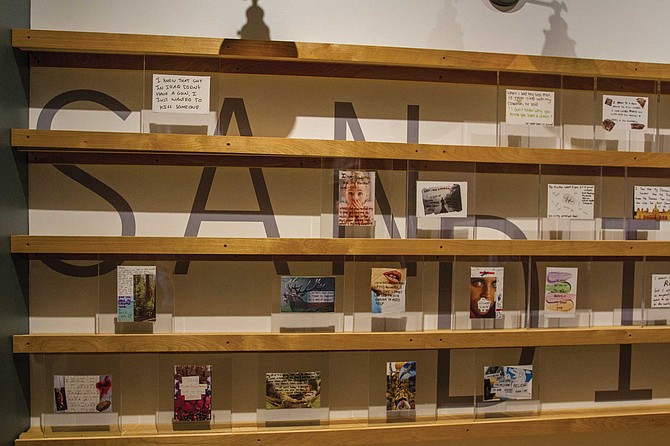
“Having feelings for my best friend isn't (sic) romantic - it’s terrifying.”
So reads a recent postcard sent to the Museum of Man in Balboa Park. It is posted on the San Diego wall of the PostSecret exhibition the museum is now displaying on its second floor. The show is based on Frank Warren’s PostSecret project, an effort that requests people to anonymously send him secrets they never or rarely share with others. In turn Warren posts many of the secrets to his blog and shares other selections on social media.
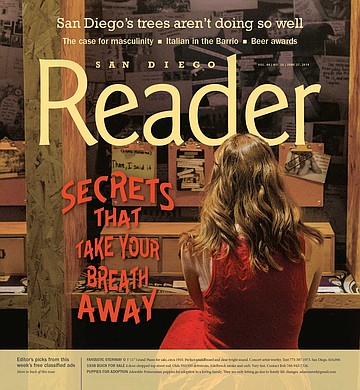
Three years ago, Frank Warren asked on his PostSecret blog what San Diego attractions he might take in during a planned visit. One answer Warren received was the San Diego Museum of Man in Balboa Park. It came from Kelly Hyberger, then the museum’s director of cultural resources and an ardent reader of the weekly blog. She wrote in her response that she would give Warren a private tour.
Hyberger didn’t think further about it. “One day she gets a call from the front desk,” says director of exhibits Erika Katayama, who is telling me the story. Warren was out front waiting to see the museum. After the tour, he said, “The mission of the museum [to inspire ‘human connections by exploring the human experience’] and the types of exhibits that you present are at the core of what PostSecret is all about. I think we could have a great partnership.”
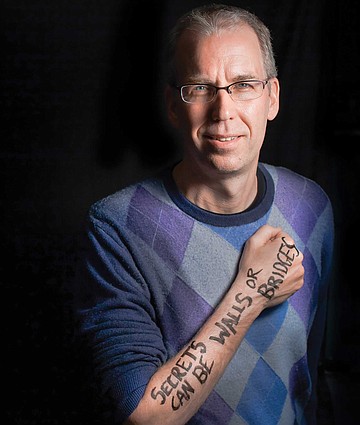
That started a conversation leading the Museum of Man to install an exhibition of Warren’s PostSecret project. “But we wanted to give it a Museum of Man stamp,” she tells me. “We wanted to make it unique for our audiences and have it speak especially to our mission.”
On April 2018, the museum’s PostSecret exhibit opened and will run at least through 2020. Katayama curated it.
I was curious about how popular the exhibit has been so far in comparison with others, such as Cannibals: Myth and Reality that is still drawing significant attention.

Although no statistics are kept on visitors to various exhibits, according to Shannon Fowler, director of marketing and communications, feedback has been coming in “anecdotally” in several ways. “We are getting comments that say people are thinking about themselves differently as a result of going through the show. Lots of people tag the museum on social media, and there have been good peer reviews. And quite a few positive evaluations on Yelp.”
Katayama and Fowler are about to lead me through the exhibit subtitled Private Secrets, Shared Publicly. As we move slowly into the show, I notice a large a colorful mural on the wall to the right.
“One thing we did to achieve a San Diego flavor was to incorporate a local artist to enhance the exhibit. His name is Buffalo, and he’s a local guerilla artist. You see his commissioned art, further inside and then again at the end,” says Katayama.
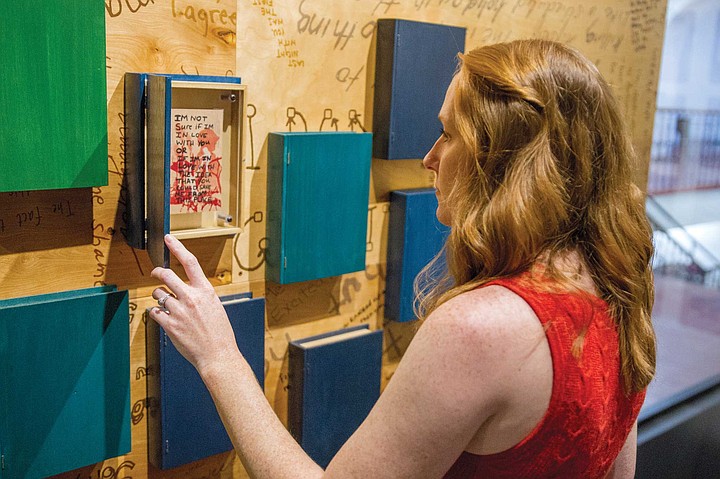
“Frank Warren sees the PostSecret project as community art, and we see our exhibition in the same way. We try to keep a balance in the way we display the postcards so that we not only have compelling secrets but visually compelling secrets. So both the content and aesthetics are important in the way we present the exhibition.”
To my right, I see a colorful mural featuring a large charging buffalo. Straight ahead, squarely in the middle of the entryway, stands a tall pillar composed of piles upon piles of postcards people have sent in to Warren’s project. On the back wall ahead of us appear numerous cryptic statements,
including a few that are written upside down. One seemingly suggestive message spells out in capital letters: MY BOYFRIEND WON’T KNOW HOW. You may chuckle at what that means. But do you truly know? The instructions for writing the cards, which include a request that people keep the message simple, as well as the anonymity of the sender, leave lots of room for speculation.
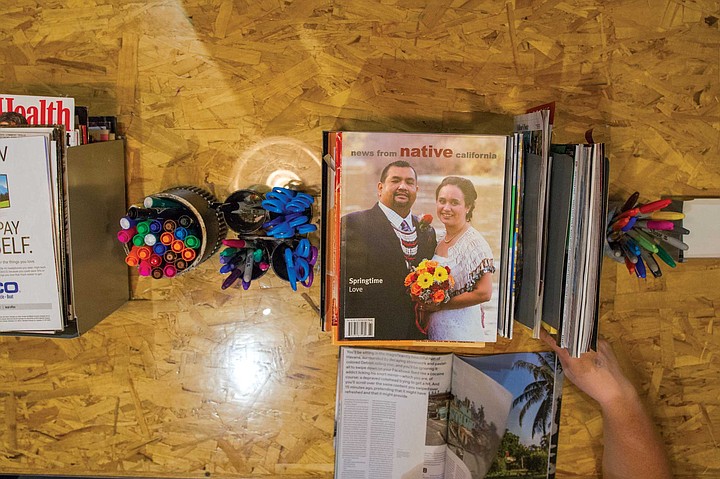
“Besides its blog,” says Katayama, “PostSecret the project, has multiple books and has been presented in multiple previous iterations, such as social media and Frank’s speaking engagements. We talk about the project as this whole at both the entrance and beginning of the exhibit. But as you are finishing up your tour, it’s distinctly San Diego. This exhibition is unique to the museum. We designed it and built it in house, and you can’t see it any place else.”
In the inner rooms, postcards cover the walls, displaying their texts and any artwork that accompanies them. Some of those cards are behind wooden book covers while others are inside old-style music album covers situated in the center of a middle room. Visitors can open both by hand.
“Of course, there are youngsters who have never experienced a vinyl recording,” Katayama tells me. But for older people, the encounter can be nostalgic. “It’s like being in a record store again. Actually, vinyl is coming back,” she says in an aside. Her point, though, is displaying some cards in this fashion gives people an additional “tactile” access and makes the exhibit more “interactive.”
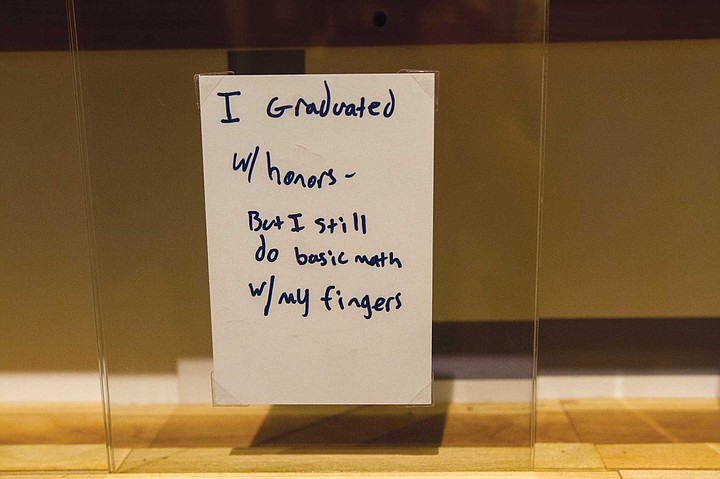
Museum staff use two methods to obtain submissions intended specifically for San Diego. “Street” or “pop-up” teams of volunteers go out occasionally into shopping malls, Balboa Park and other public places to hand out the pre-addressed postcards people can send back to the museum. That supplements postcards museum visitors fill out during their walk-through. In the last room visitors see, a long table is available with colored markers, magazines for cutting out pictures and glue to attach them to the cards.
The San Diego wall, in the exhibit’s innermost sanctum, holds a full spectrum of the types of secrets the PostSecret project has been getting from its inception. They run the gamut of positive and negative expressions,” according to Katayama. “We try to keep a balance in the way we display the cards so that we not only have compelling secrets but visually compelling secrets. Both the content and aesthetics are important in the way we present the exhibition.
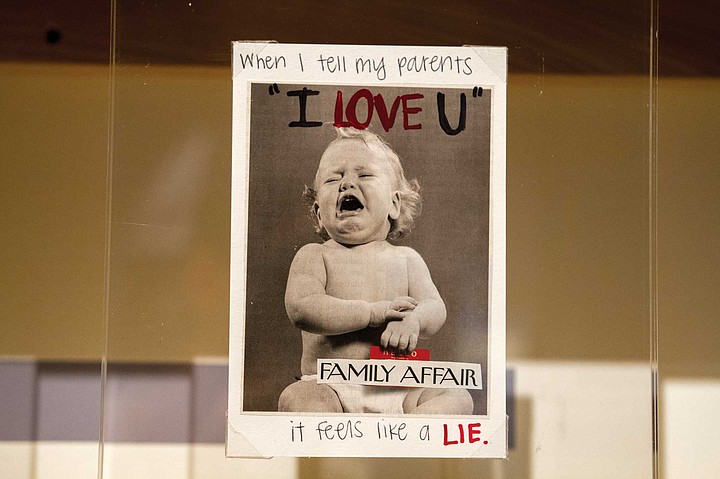
“People find as they go through that some secrets can take your breath away and others where they go, ‘Yeah, that’s me’ or ‘Yeah, I understand this because I was there once in my life.’ I think that’s why this exhibit is hitting home for so many people.
Here are two San Diego cards.
The picture has a line that winds back and forth and, in the spaces it creates, colored lavender, green, brown, the following words: “I’ve always felt like I’m the ugly duckling in my friend group.”
A card with the lower half of a female face pictures light red lipstick traced around the lips by a dark red line and words in black written on a blue background, saying: “I’M IN EATING DISORDER AND PTSD RECOVERY, & EVERY DAY I DOUBT WHETHER I’M SICK ENOUGH TO NEED HELP.”
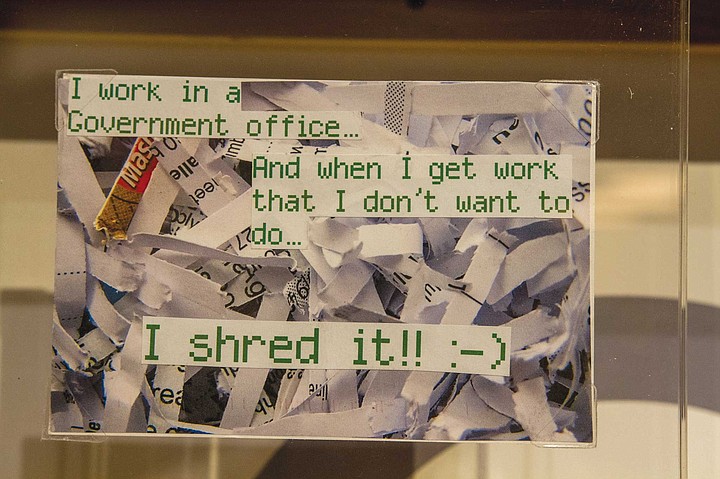
“We recognized that not everyone will want to sit at the table next to their family or others who came in their group as they write down their secrets,” says Katayama. “So we created a small private space for people to sit against the back wall and create the submissions they will leave.”
As I perused the San Diego wall, I didn’t know what to make of one message written on a bare card. “I knew that guy in Iraq didn’t have a gun,” it reads. “I just wanted to kill someone.”
My first inclination is to think a soldier wrote it.
“Not necessarily,” says Katayama. “It could have been a contractor.”
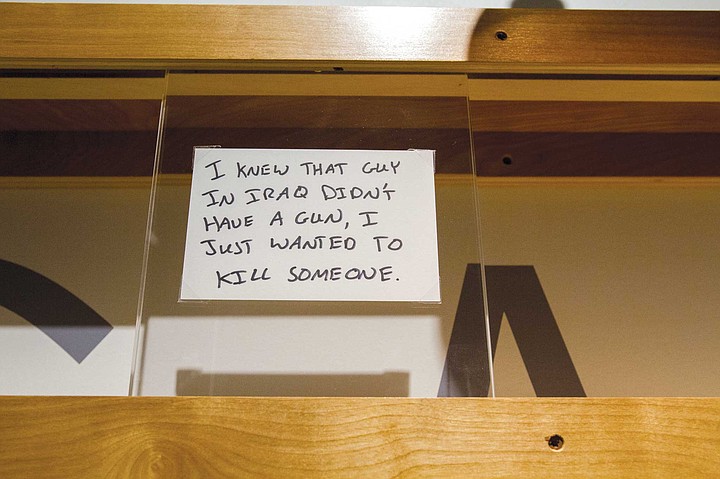
“Or possibly someone trying to take a political jab, an ironic anti-war statement perhaps?”
“Yes, we just don’t know,” she tells me, suggesting that I ask Warren if he has learned how to detect messages that are inauthentic.
By phone from his home in Orange County, Warren gives the kind of sophisticated reply that one might expect from someone who for years has been reading hundreds of thousands of the secrets. He first compares journalism to the artistic expression of the secrets. “The question is, is this true? PostSecret is an art project. For a journalist like yourself,” he says, “statements are more authentic if the journalist has trustworthy sources for them. But in the way that fiction often is more insightful than what’s reported in a newspaper, somebody making up a secret is still expressing something authentic about himself. He may be coming out to himself and will experience self discovery if he sees the secret later, on the blog for instance.”
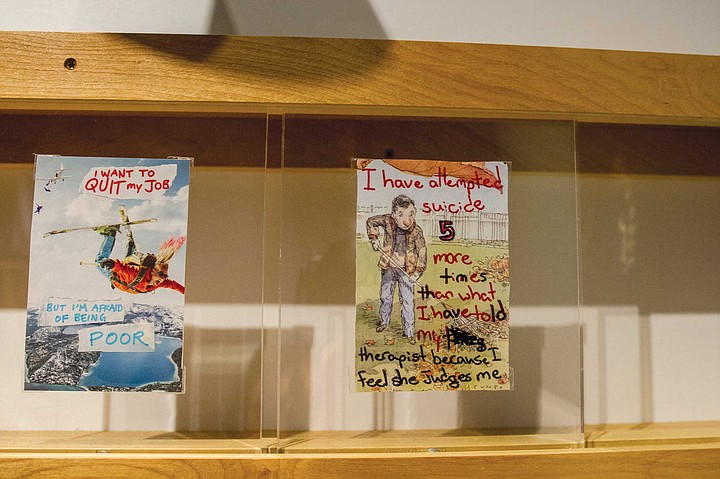
Do the locations where groups of secrets come from influence the nature of their content? “Yes,” says Warren, “if you think of secrets coming from a church group versus, say, a sports venue, that is likely to predispose them differently.”
So the secrets coming out of San Diego are likely in general to be characteristic of ones that San Diego residents would write. “Yes, the origins of secrets coming from Hawaii or Berlin, for instance, or San Diego could be influential.”
Viewers, however, might find it difficult to see anything especially unique to San Diego on the wall the museum dedicates to its secrets. The city is so crowded with tourists that, when the pop-up teams go out to rustle up submissions, one can never feel certain the contributors are San Diegans. The same reasoning would apply to the many people here connected to the military. They so often have only recently come from somewhere else.
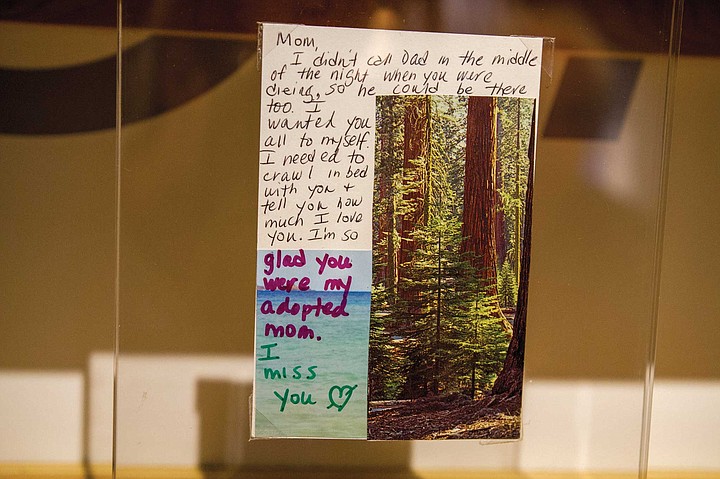
The San Diego wall displays a wide variety of confessions, many that one might naturally expect to see. Katayama changes all of them out quarterly from the approximately 5000 she’s read so far. For instance.
“I steal groceries when the line is too long.”
“I wanted to be filthy RICH but I also work in non-profit and want to do good in the world.” Then across the card, on its other half , “How do I get both?”
“My stutter prevents me from expressing myself the way I should.”
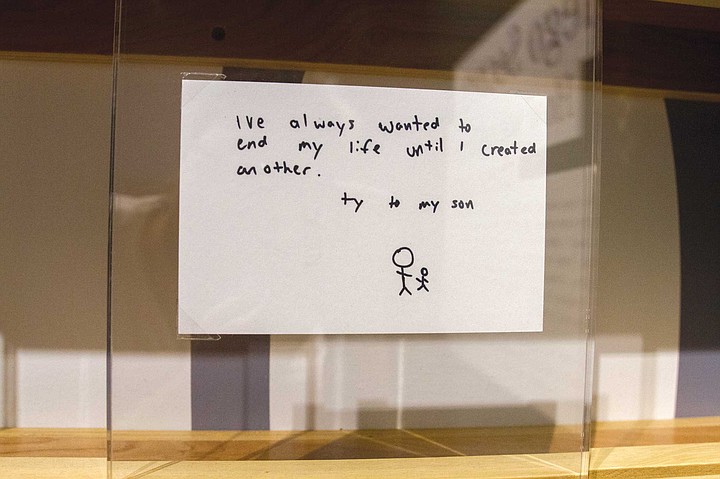
Years ago, two people Frank Warren was close to in his private life committed suicide, something that prompted him to volunteer to take calls on a suicide hotline in the Washington, D.C. area. “During shifts between midnight to 4 am, people spoke to me anonymously in deep conversations,” he tells me. “It was not our job to solve their problems or make them happy but just to listen attentively and be supportive and compassionate.”
After participating in many secret conversations while manning the phones, Warren began experimenting with how to encourage everybody to reveal the secrets they keep. His work with extremely depressed individuals had suggested to him that opening up one’s interior life could give a huge boost to their mental health.
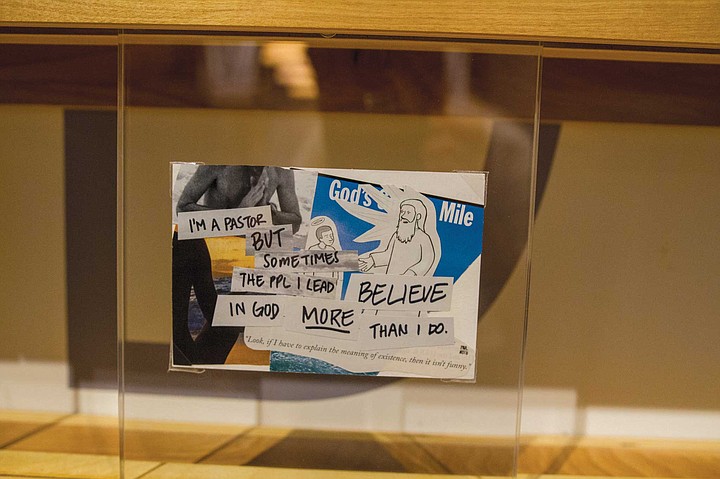
But Warren sensed that successfully taking that step could only be undertaken by many people, perhaps those who need it most, in baby steps. So like most of the anxieties and desperation confided to him in suicide prevention, their revelation would have to occur anonymously. Ah hah! Would people be willing to write a secret and send it to him without identifying themselves? He put an original 3000 cards out in public places requesting secrets be sent to his home. After a few weeks a few trickled in. As time went on many more came. By now, he has collected over a million secrets. They come every week in his mailbox at home, and he reads every one.
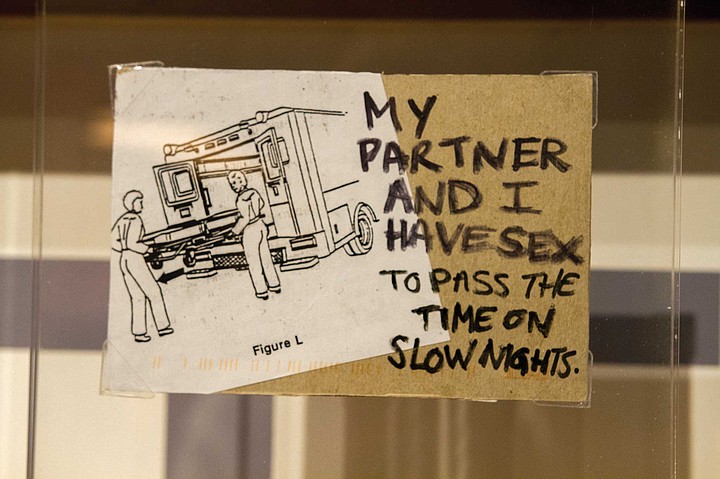
What prompted Warren more than anything else to experiment with PostSecret, he thinks, was “finding the voice of empathy” through a weeks-long training he had received to work on the suicide hotline. As trainees, we practiced by sitting back to back on chairs in the basement of a church until answering the ring ring of a telephone in a non-judgemental, inviting tone that expressed active listening and avoided negative expressions such as sarcasm.”
I ask Warren if he ever writes comments on the secrets that appear on his blog. “Only if I receive later feedback from a secret’s writer, something that happens usually by email. For a short time some years ago, I allowed readers to comment, too. But there were people who reacted to some secrets in judgmental ways. So I stopped that. Of course, on the various social media platforms it’s almost inescapable and free-for-alls will happen over a particular secret or another.”
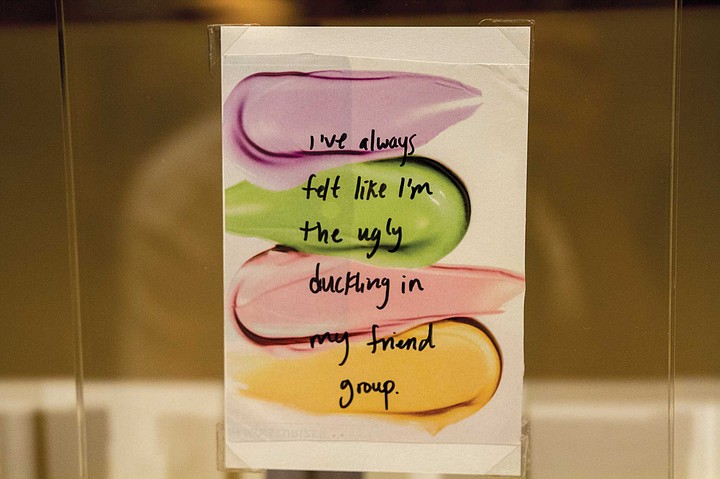
However, on a blog post for the week of June 2 to June 9, 2019, Warren copied emails from two disgruntled participants in the PostSecret community. Both complained about his allowing the “trolling” of secrets on Instagram. The first states, “It’s really sad how hurtful people are and you just let them be. PostSecret was always a safe place. Wasn’t that why you created [it]? So people could express themselves without feeling like they would be judged and/or mocked. Now it’s become a place for bullies, trolls and harassment. It breaks my heart.”
The second is longer. It reads in part, “I feel disappointed and betrayed by PostSecret. I’ve watched your videos, TED talk, interview on TED Radio hour and your message is consistent: secrets are powerful, vulnerable and, and in your own words the ‘currency of intimacy.’”
The email cited 322 comments, not mentioning whether all were negative, on a teacher’s secret admission that “I sometimes make up the grades…” One of the trolls wrote, “That’s bullshit!!! If you don’t like teaching, do something else!!! These kids study and stress and you f$@” with their grades…. Shame on you!!”
Warren believes in free and open expression and has always eschewed censorship. But in response to the criticisms, he promises now to turn “off comments on Instagram as an experiment. (It is not possible to turn off comments on Facebook).”
The teacher’s confession is similar to one on a wall in the Museum of Man’s exhibit, although not one on the San Diego wall. It reads, “I made a student repeat a grade so that I could flirt with his father for one more year.”
The critics may have assumed that the teachers above were bragging about what they did. But isn’t it equally likely, if not more so, that they were confessing shame at having done wrong. I notice on going through the museum’s exhibit that quite a few secrets express a painful awareness that the faces people put to the world are often at odds with their true selves.
Consider this more trivial secret. “I graduated with honors — but I still do basic math w/ my fingers.”
Disappointment with self seems most likely behind the card which depicts two stick figure characters staring at each other across a table: “I don’t know how to have a conversation w/ people; it always ends up with that awkward silence.”
Or, “I’ve lied to everyone I’ve ever met.” Then on the right side of the card, “Maybe I’ll have changed by the time I find this again.”
And, “When I have a problem, I end up telling someone who can’t help. One day I hope I tell someone who can.”
How about this one? “I avoid social situations because happy people depress me.”
In addition to self-criticism, a religious or quasi-religious issue is often the subject of secrets.
“I’m a pastor. BUT sometimes the ppl I lead BELIEVE IN GOD MORE than I do.”
“I’d rather tell my secrets to Jesus because He’ll forgive them”
“God’s love has healed me and I wish I could share that with my psychiatrist….
… without her thinking I’m delusional.”
“I don’t believe in God anymore, but I talk to my Grandpa a lot. He lives in heaven.”
How can relationships be overlooked, the joys and problems of romantic and marital ones, not to mention other types?
“I wish I could tell her how much I love her” alongside a picture of a young man on a bench at an outdoor table with his face buried in his crossed arms.
On the left side of a card, slanting upward, the words, “New Weight Loss Discovery.” Then centered, using for key words the colors pink, purple, blue, red, green. “He loved me at 130 continued to cherish me at 210 and still worships me at 170. I can never thank him enough for always making me feel beautiful and worthy enough.”
But then, “My GF of 4 [and a half] years took me to PostSecret SD. So I wrote a bunch of my own and wanted to share them with her. She didn’t want to share hers with me. Up until today, I thought she was the one person I could share anything and everything with. Guess I’m wrong.”
Different types of relationships:
“I didn’t call Dad in the middle of the night when you were dieing (sic), so he could be there too. I wanted you all to myself. I needed to crawl in bed with you + tell you how much I love you. I’m so glad you were my adopted mom. I miss you.” Followed by a picture of a heart with an arrow through it.
“This picture was taken just before my hit that won the championship game that you didn’t come to.” The picture on the card is of an ongoing baseball game from the first base side.
What to make of this relationship? “I think I would feel better if I shoved his clubs up his ASS.” The picture is of 2 crossed golf clubs.
Fear is the subject of some of the most intense secrets.
When I told my boss that I’d never sleep with my co-worker, he said, “I don’t know why you think you have a choice.” Then, at the card’s bottom, “I’ve never been so scared.”
“No matter where I am, if I am out in public, I am planning my escape from an active shooter situation.” At the card’s bottom, “It is my greatest fear.”
“Im studying to become a police officer. I want to bridge the gap between law enforcement and the community. But I’m scared those same community members I’m trying to help will gun me down before I get a chance.” Again, below, at bottom, “I want to help. Don’t kill me.”
“I can’t tell my parents where I am deployed or when I’ll be home. And if I die they can’t be told why.”
Sexuality or fear thereof.
“One day a man came over to fix the heater I took off my shirt and stood there for a full ten minutes. He never looked up from what he was doing”
“I imagine VAGINAS have teeth like prince charles.”
“It’s hard for me to concentrate when I have a meeting with my boss” with the picture of a man with no eyes, nose or mouth at a desk but a title of THE BOSS below him “because I would love to tear off his suit and fuck him.”
What is it that fascinates us about other people’s secrets? “It’s kind of a voyeuristic peek into people’ private lives,” says Frank Warren. “The secrets then allow us to feel connected. And we realize we have more in common with people we don’t even know than we thought we did. I like to say we are alone together.”
When I ask Erika Katayama what was hardest about curating the PostSecret exhibit, I expected she might say something about its complexity or unusual nature for a museum. Unlike other exhibits she has put together almost from scratch, she tells me, “We had Frank Warren’s project to work from. What was hardest for me was how emotionally burdensome going through so many secrets became. I find some of them terrifying. I could only look at them for about an hour a day.”
For a last look, consider a black and white photo of a distraught man looking off to the right as the background for: “It happens gradually and then suddenly you are AFRAID to live.” The simplicity and stark brevity of the despairing expression are what terrifies.
It is useful to remember that Warren’s immersion into secrets started with his dealing with suicide.
“We were mindful that some people might have strong emotional reactions to certain painful sounding secrets,” says Katayama. “We are not in the business of therapy. But at several points in the exhibit we put out contact information for people to use if they need help.”
One prays that these experiences are only brushes with suicide and hope reemerges. “I’ve always wanted to end my life until I created another.... ty to my son”
The art is a simple stick figure drawing of an adult and a child.


“Having feelings for my best friend isn't (sic) romantic - it’s terrifying.”
So reads a recent postcard sent to the Museum of Man in Balboa Park. It is posted on the San Diego wall of the PostSecret exhibition the museum is now displaying on its second floor. The show is based on Frank Warren’s PostSecret project, an effort that requests people to anonymously send him secrets they never or rarely share with others. In turn Warren posts many of the secrets to his blog and shares other selections on social media.

Three years ago, Frank Warren asked on his PostSecret blog what San Diego attractions he might take in during a planned visit. One answer Warren received was the San Diego Museum of Man in Balboa Park. It came from Kelly Hyberger, then the museum’s director of cultural resources and an ardent reader of the weekly blog. She wrote in her response that she would give Warren a private tour.
Hyberger didn’t think further about it. “One day she gets a call from the front desk,” says director of exhibits Erika Katayama, who is telling me the story. Warren was out front waiting to see the museum. After the tour, he said, “The mission of the museum [to inspire ‘human connections by exploring the human experience’] and the types of exhibits that you present are at the core of what PostSecret is all about. I think we could have a great partnership.”

That started a conversation leading the Museum of Man to install an exhibition of Warren’s PostSecret project. “But we wanted to give it a Museum of Man stamp,” she tells me. “We wanted to make it unique for our audiences and have it speak especially to our mission.”
On April 2018, the museum’s PostSecret exhibit opened and will run at least through 2020. Katayama curated it.
I was curious about how popular the exhibit has been so far in comparison with others, such as Cannibals: Myth and Reality that is still drawing significant attention.

Although no statistics are kept on visitors to various exhibits, according to Shannon Fowler, director of marketing and communications, feedback has been coming in “anecdotally” in several ways. “We are getting comments that say people are thinking about themselves differently as a result of going through the show. Lots of people tag the museum on social media, and there have been good peer reviews. And quite a few positive evaluations on Yelp.”
Katayama and Fowler are about to lead me through the exhibit subtitled Private Secrets, Shared Publicly. As we move slowly into the show, I notice a large a colorful mural on the wall to the right.
“One thing we did to achieve a San Diego flavor was to incorporate a local artist to enhance the exhibit. His name is Buffalo, and he’s a local guerilla artist. You see his commissioned art, further inside and then again at the end,” says Katayama.

“Frank Warren sees the PostSecret project as community art, and we see our exhibition in the same way. We try to keep a balance in the way we display the postcards so that we not only have compelling secrets but visually compelling secrets. So both the content and aesthetics are important in the way we present the exhibition.”
To my right, I see a colorful mural featuring a large charging buffalo. Straight ahead, squarely in the middle of the entryway, stands a tall pillar composed of piles upon piles of postcards people have sent in to Warren’s project. On the back wall ahead of us appear numerous cryptic statements,
including a few that are written upside down. One seemingly suggestive message spells out in capital letters: MY BOYFRIEND WON’T KNOW HOW. You may chuckle at what that means. But do you truly know? The instructions for writing the cards, which include a request that people keep the message simple, as well as the anonymity of the sender, leave lots of room for speculation.

“Besides its blog,” says Katayama, “PostSecret the project, has multiple books and has been presented in multiple previous iterations, such as social media and Frank’s speaking engagements. We talk about the project as this whole at both the entrance and beginning of the exhibit. But as you are finishing up your tour, it’s distinctly San Diego. This exhibition is unique to the museum. We designed it and built it in house, and you can’t see it any place else.”
In the inner rooms, postcards cover the walls, displaying their texts and any artwork that accompanies them. Some of those cards are behind wooden book covers while others are inside old-style music album covers situated in the center of a middle room. Visitors can open both by hand.
“Of course, there are youngsters who have never experienced a vinyl recording,” Katayama tells me. But for older people, the encounter can be nostalgic. “It’s like being in a record store again. Actually, vinyl is coming back,” she says in an aside. Her point, though, is displaying some cards in this fashion gives people an additional “tactile” access and makes the exhibit more “interactive.”

Museum staff use two methods to obtain submissions intended specifically for San Diego. “Street” or “pop-up” teams of volunteers go out occasionally into shopping malls, Balboa Park and other public places to hand out the pre-addressed postcards people can send back to the museum. That supplements postcards museum visitors fill out during their walk-through. In the last room visitors see, a long table is available with colored markers, magazines for cutting out pictures and glue to attach them to the cards.
The San Diego wall, in the exhibit’s innermost sanctum, holds a full spectrum of the types of secrets the PostSecret project has been getting from its inception. They run the gamut of positive and negative expressions,” according to Katayama. “We try to keep a balance in the way we display the cards so that we not only have compelling secrets but visually compelling secrets. Both the content and aesthetics are important in the way we present the exhibition.

“People find as they go through that some secrets can take your breath away and others where they go, ‘Yeah, that’s me’ or ‘Yeah, I understand this because I was there once in my life.’ I think that’s why this exhibit is hitting home for so many people.
Here are two San Diego cards.
The picture has a line that winds back and forth and, in the spaces it creates, colored lavender, green, brown, the following words: “I’ve always felt like I’m the ugly duckling in my friend group.”
A card with the lower half of a female face pictures light red lipstick traced around the lips by a dark red line and words in black written on a blue background, saying: “I’M IN EATING DISORDER AND PTSD RECOVERY, & EVERY DAY I DOUBT WHETHER I’M SICK ENOUGH TO NEED HELP.”

“We recognized that not everyone will want to sit at the table next to their family or others who came in their group as they write down their secrets,” says Katayama. “So we created a small private space for people to sit against the back wall and create the submissions they will leave.”
As I perused the San Diego wall, I didn’t know what to make of one message written on a bare card. “I knew that guy in Iraq didn’t have a gun,” it reads. “I just wanted to kill someone.”
My first inclination is to think a soldier wrote it.
“Not necessarily,” says Katayama. “It could have been a contractor.”

“Or possibly someone trying to take a political jab, an ironic anti-war statement perhaps?”
“Yes, we just don’t know,” she tells me, suggesting that I ask Warren if he has learned how to detect messages that are inauthentic.
By phone from his home in Orange County, Warren gives the kind of sophisticated reply that one might expect from someone who for years has been reading hundreds of thousands of the secrets. He first compares journalism to the artistic expression of the secrets. “The question is, is this true? PostSecret is an art project. For a journalist like yourself,” he says, “statements are more authentic if the journalist has trustworthy sources for them. But in the way that fiction often is more insightful than what’s reported in a newspaper, somebody making up a secret is still expressing something authentic about himself. He may be coming out to himself and will experience self discovery if he sees the secret later, on the blog for instance.”

Do the locations where groups of secrets come from influence the nature of their content? “Yes,” says Warren, “if you think of secrets coming from a church group versus, say, a sports venue, that is likely to predispose them differently.”
So the secrets coming out of San Diego are likely in general to be characteristic of ones that San Diego residents would write. “Yes, the origins of secrets coming from Hawaii or Berlin, for instance, or San Diego could be influential.”
Viewers, however, might find it difficult to see anything especially unique to San Diego on the wall the museum dedicates to its secrets. The city is so crowded with tourists that, when the pop-up teams go out to rustle up submissions, one can never feel certain the contributors are San Diegans. The same reasoning would apply to the many people here connected to the military. They so often have only recently come from somewhere else.

The San Diego wall displays a wide variety of confessions, many that one might naturally expect to see. Katayama changes all of them out quarterly from the approximately 5000 she’s read so far. For instance.
“I steal groceries when the line is too long.”
“I wanted to be filthy RICH but I also work in non-profit and want to do good in the world.” Then across the card, on its other half , “How do I get both?”
“My stutter prevents me from expressing myself the way I should.”

Years ago, two people Frank Warren was close to in his private life committed suicide, something that prompted him to volunteer to take calls on a suicide hotline in the Washington, D.C. area. “During shifts between midnight to 4 am, people spoke to me anonymously in deep conversations,” he tells me. “It was not our job to solve their problems or make them happy but just to listen attentively and be supportive and compassionate.”
After participating in many secret conversations while manning the phones, Warren began experimenting with how to encourage everybody to reveal the secrets they keep. His work with extremely depressed individuals had suggested to him that opening up one’s interior life could give a huge boost to their mental health.

But Warren sensed that successfully taking that step could only be undertaken by many people, perhaps those who need it most, in baby steps. So like most of the anxieties and desperation confided to him in suicide prevention, their revelation would have to occur anonymously. Ah hah! Would people be willing to write a secret and send it to him without identifying themselves? He put an original 3000 cards out in public places requesting secrets be sent to his home. After a few weeks a few trickled in. As time went on many more came. By now, he has collected over a million secrets. They come every week in his mailbox at home, and he reads every one.

What prompted Warren more than anything else to experiment with PostSecret, he thinks, was “finding the voice of empathy” through a weeks-long training he had received to work on the suicide hotline. As trainees, we practiced by sitting back to back on chairs in the basement of a church until answering the ring ring of a telephone in a non-judgemental, inviting tone that expressed active listening and avoided negative expressions such as sarcasm.”
I ask Warren if he ever writes comments on the secrets that appear on his blog. “Only if I receive later feedback from a secret’s writer, something that happens usually by email. For a short time some years ago, I allowed readers to comment, too. But there were people who reacted to some secrets in judgmental ways. So I stopped that. Of course, on the various social media platforms it’s almost inescapable and free-for-alls will happen over a particular secret or another.”

However, on a blog post for the week of June 2 to June 9, 2019, Warren copied emails from two disgruntled participants in the PostSecret community. Both complained about his allowing the “trolling” of secrets on Instagram. The first states, “It’s really sad how hurtful people are and you just let them be. PostSecret was always a safe place. Wasn’t that why you created [it]? So people could express themselves without feeling like they would be judged and/or mocked. Now it’s become a place for bullies, trolls and harassment. It breaks my heart.”
The second is longer. It reads in part, “I feel disappointed and betrayed by PostSecret. I’ve watched your videos, TED talk, interview on TED Radio hour and your message is consistent: secrets are powerful, vulnerable and, and in your own words the ‘currency of intimacy.’”
The email cited 322 comments, not mentioning whether all were negative, on a teacher’s secret admission that “I sometimes make up the grades…” One of the trolls wrote, “That’s bullshit!!! If you don’t like teaching, do something else!!! These kids study and stress and you f$@” with their grades…. Shame on you!!”
Warren believes in free and open expression and has always eschewed censorship. But in response to the criticisms, he promises now to turn “off comments on Instagram as an experiment. (It is not possible to turn off comments on Facebook).”
The teacher’s confession is similar to one on a wall in the Museum of Man’s exhibit, although not one on the San Diego wall. It reads, “I made a student repeat a grade so that I could flirt with his father for one more year.”
The critics may have assumed that the teachers above were bragging about what they did. But isn’t it equally likely, if not more so, that they were confessing shame at having done wrong. I notice on going through the museum’s exhibit that quite a few secrets express a painful awareness that the faces people put to the world are often at odds with their true selves.
Consider this more trivial secret. “I graduated with honors — but I still do basic math w/ my fingers.”
Disappointment with self seems most likely behind the card which depicts two stick figure characters staring at each other across a table: “I don’t know how to have a conversation w/ people; it always ends up with that awkward silence.”
Or, “I’ve lied to everyone I’ve ever met.” Then on the right side of the card, “Maybe I’ll have changed by the time I find this again.”
And, “When I have a problem, I end up telling someone who can’t help. One day I hope I tell someone who can.”
How about this one? “I avoid social situations because happy people depress me.”
In addition to self-criticism, a religious or quasi-religious issue is often the subject of secrets.
“I’m a pastor. BUT sometimes the ppl I lead BELIEVE IN GOD MORE than I do.”
“I’d rather tell my secrets to Jesus because He’ll forgive them”
“God’s love has healed me and I wish I could share that with my psychiatrist….
… without her thinking I’m delusional.”
“I don’t believe in God anymore, but I talk to my Grandpa a lot. He lives in heaven.”
How can relationships be overlooked, the joys and problems of romantic and marital ones, not to mention other types?
“I wish I could tell her how much I love her” alongside a picture of a young man on a bench at an outdoor table with his face buried in his crossed arms.
On the left side of a card, slanting upward, the words, “New Weight Loss Discovery.” Then centered, using for key words the colors pink, purple, blue, red, green. “He loved me at 130 continued to cherish me at 210 and still worships me at 170. I can never thank him enough for always making me feel beautiful and worthy enough.”
But then, “My GF of 4 [and a half] years took me to PostSecret SD. So I wrote a bunch of my own and wanted to share them with her. She didn’t want to share hers with me. Up until today, I thought she was the one person I could share anything and everything with. Guess I’m wrong.”
Different types of relationships:
“I didn’t call Dad in the middle of the night when you were dieing (sic), so he could be there too. I wanted you all to myself. I needed to crawl in bed with you + tell you how much I love you. I’m so glad you were my adopted mom. I miss you.” Followed by a picture of a heart with an arrow through it.
“This picture was taken just before my hit that won the championship game that you didn’t come to.” The picture on the card is of an ongoing baseball game from the first base side.
What to make of this relationship? “I think I would feel better if I shoved his clubs up his ASS.” The picture is of 2 crossed golf clubs.
Fear is the subject of some of the most intense secrets.
When I told my boss that I’d never sleep with my co-worker, he said, “I don’t know why you think you have a choice.” Then, at the card’s bottom, “I’ve never been so scared.”
“No matter where I am, if I am out in public, I am planning my escape from an active shooter situation.” At the card’s bottom, “It is my greatest fear.”
“Im studying to become a police officer. I want to bridge the gap between law enforcement and the community. But I’m scared those same community members I’m trying to help will gun me down before I get a chance.” Again, below, at bottom, “I want to help. Don’t kill me.”
“I can’t tell my parents where I am deployed or when I’ll be home. And if I die they can’t be told why.”
Sexuality or fear thereof.
“One day a man came over to fix the heater I took off my shirt and stood there for a full ten minutes. He never looked up from what he was doing”
“I imagine VAGINAS have teeth like prince charles.”
“It’s hard for me to concentrate when I have a meeting with my boss” with the picture of a man with no eyes, nose or mouth at a desk but a title of THE BOSS below him “because I would love to tear off his suit and fuck him.”
What is it that fascinates us about other people’s secrets? “It’s kind of a voyeuristic peek into people’ private lives,” says Frank Warren. “The secrets then allow us to feel connected. And we realize we have more in common with people we don’t even know than we thought we did. I like to say we are alone together.”
When I ask Erika Katayama what was hardest about curating the PostSecret exhibit, I expected she might say something about its complexity or unusual nature for a museum. Unlike other exhibits she has put together almost from scratch, she tells me, “We had Frank Warren’s project to work from. What was hardest for me was how emotionally burdensome going through so many secrets became. I find some of them terrifying. I could only look at them for about an hour a day.”
For a last look, consider a black and white photo of a distraught man looking off to the right as the background for: “It happens gradually and then suddenly you are AFRAID to live.” The simplicity and stark brevity of the despairing expression are what terrifies.
It is useful to remember that Warren’s immersion into secrets started with his dealing with suicide.
“We were mindful that some people might have strong emotional reactions to certain painful sounding secrets,” says Katayama. “We are not in the business of therapy. But at several points in the exhibit we put out contact information for people to use if they need help.”
One prays that these experiences are only brushes with suicide and hope reemerges. “I’ve always wanted to end my life until I created another.... ty to my son”
The art is a simple stick figure drawing of an adult and a child.
Comments